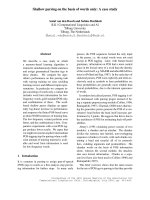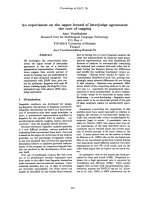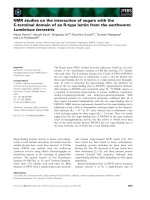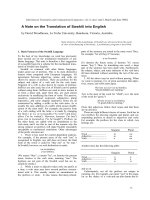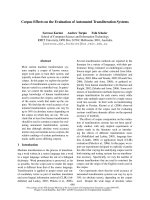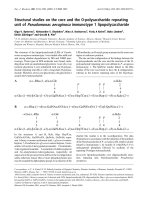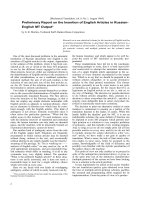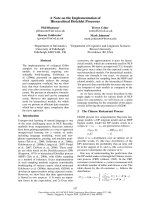Báo cáo sinh học: "Globin genes on the move" docx
Bạn đang xem bản rút gọn của tài liệu. Xem và tải ngay bản đầy đủ của tài liệu tại đây (147.21 KB, 5 trang )
Minireview
GGlloobbiinn ggeenneess oonn tthhee mmoovvee
Ross C Hardison
Address: Center for Comparative Genomics and Bioinformatics, Huck Institutes of Life Sciences and Department of Biochemistry and
Molecular Biology, The Pennsylvania State University, University Park, PA 16802, USA. Email:
TThhee iimmppoorrttaannccee ooff hheemmoogglloobbiinn pprrootteeiinnss aanndd ggeenneess
In metazoans, hemoglobin carries oxygen from the lungs,
gills or other respiratory organs to peripheral tissues that need
the oxygen for efficient metabolism. Hemoglobin is
composed of one or more globin polypeptide chains, which
bind the iron-containing cofactor heme. Other organisms use
the oxygen-binding and redox capacity of hemoglobin in a
variety of other ways. Most multicellular species produce
distinctive forms of hemoglobin at different developmental
stages.
Studies of globin genes and their evolution are driven by a
desire to understand how this diversity of protein structures and
functions was generated. Current evolutionary ideas about gene
duplication and divergence had their origin in studies of
hemoglobin genes and other multigene families. In addition,
interest in the hemoglobin genes is fueled by the realization that
the most common genetic diseases in humans, such as sickle
cell disease and inherited anemias, result from pathological
variants in the hemoglobin genes. The quest to understand
normal hemoglobin production and function and to learn what
goes wrong in hemoglobinopathies should provide insights that
could lead to effective therapeutic interventions.
The hemoglobins found in erythroid cells of jawed vertebrates
(gnathostomes) include two α-like globins and two β-like
globins, each bound by a heme molecule. Although the
hemoglobins produced in embryonic or larval erythrocytes
differ from those in adult erythrocytes, each has two copies
of a polypeptide related to α-globin, such as the embryonic
ζ-globin, and two copies of a polypeptide related to β-
globin, such as the embryonic ε-globin. The α-like and β-like
globin gene clusters are on different chromosomes in
mammals and birds, but one or more pairs of α-like and β-
like globin genes are found in one locus in amphibians and
fish (Figure 1). The arrangement of genes in these
contemporary species strongly suggested that either α-like or
β-like globin genes moved to a new chromosomal location
in the ancestor of birds and mammals [1]. How this
occurred, whether by duplication and specific gene loss or by
translocation of one type of gene, was far from clear. This
mechanism and the effects such a movement had on the
regulation of the genes are intriguing questions, and recent
work, such as that of Patel et al. published recently in BMC
Biology [2], has shed much light on them.
MMuullttiippllee gglloobbiinn ggeennee cclluusstteerrss
One globin gene cluster is found in all gnathostomes
examined, but frequently, perhaps invariably, it is accom-
panied by another globin gene cluster at a different genetic
locus. The globin genes in the common cluster are flanked
AAbbssttrraacctt
Recent data published in
BMC Biology
from the globin gene clusters in platypus, together with
data from other species, show that β-globin genes transposed from one chromosomal
location to another. This resolves some controversies about vertebrate globin gene evolution
but ignites new ones.
Journal of Biology
2008,
77::
35
Published: 20 November 2008
Journal of Biology
2008,
77::
35 (doi:10.1186/jbiol92)
The electronic version of this article is the complete one and can be
found online at />© 2008 BioMed Central Ltd
by the genes MPG and C16orf35 ‘upstream’ of the globin
genes [3], and I will thus refer to this locus as ‘MC’, after
these two genes (Figure 1). The major DNA region regulating
expression of the globin genes (major regulatory element,
MRE) is located in an intron of C16orf35. Frequently, the
gene RHBDF1 is adjacent to the MPG gene. In placental
mammals and chickens, only α-like globin genes (both
embryonic and adult) are in this locus, whereas in
amphibians [4] and fish [3], the α-globin genes are paired
with β-globin genes (Figure 1). The new analysis of platypus
globin genes by Patel et al. [2] shows that a β-like globin
gene, the ω-globin gene, is closely linked to the α-like globin
genes, just as it is in marsupials [5]. In addition, a platypus
homolog to the gene for globin Y (GBY), a globin discovered
in amphibians, is also in this locus [2]. Given its presence in
all gnathostomes examined, we can infer with considerable
confidence that the MC locus contained globin genes in the
last common ancestor (LCA) of vertebrates (Figure 1).
A second locus contains α- and β-globin genes in the
pufferfish Fugu rubripes [6], and examination of the genome
assemblies of zebrafish and Medaka shows a similar arrange-
ment (Figure 1). The globin genes in this locus are flanked by
the genes LCMT1 and AQP8, and thus I will refer to it as the
35.2
Journal of Biology
2008, Volume 7, Article 35 Hardison />Journal of Biology
2008,
77::
35
FFiigguurree 11
One model for movement of globin genes during the evolution of jawed vertebrates. Top, gene clusters in contemporary species; bottom, inferred
gene arrangements in the last common ancestor to jawed vertebrates; middle, some of the possible gene movements mapped onto an evolutionary
tree (thick gray lines). Genes are indicated by boxes, with those above the line transcribed from left to right and those below the line from the right;
red, β-like globin genes; yellow, α-like globin genes; light blue, OR genes; other colors, other genes; small orange circles, major regulatory regions.
All the known genes encoding hemoglobins expressed in erythroid cells are shown, as well as other genes that are most consistently diagnostic for
the loci. Numbers to the left of each cluster specify the chromosome on which it is located; for the frog gene clusters, the scaffold number
(preceded by s) is given. The Greek letter name is specified for hemoglobin genes in human, platypus and chicken, but generic ‘α-globin’ or ‘β-globin’
is used for frog and fish because the genes are less well characterized. In the
X. tropicalis
genome assembly (version 4.1), scaffolds 733 and 357 are
not connected. Maps of the gene clusters were derived from a combination of the assembled genomes and recent publications [2,4,15]. The gene
maps are not complete or to scale; see [2,4] or the genome assemblies for more complete information.
ARHGAP17
AQP8
LCMT1
α
β
α
β
RRM1
STIM1
DCHS1
OR genes
RHBDF1
MPG
C16orf35
ααα
βββ
MRE
MC DS LA
Jawed vertebrate ancestor
µζ αα θαζ
α
α
β
µζ αα ωαζ
GBY
ααπ
D
A
γεηγ βδ
AH
εββ
ρ
FOLR1
ββ
?
?
MC
DS
LA
Human Platypus Chicken
Frog (X. tropicalis)
Fish (Medaka)
α
α
αα
βββ
β
β
α
β
16
11
16
2
2
21
14
s357
s1078+
s27
βββββRHBDF1
GBY
s733
1
14
8
13
19
MC
DS
LA
ααα
β
β
?
?
ααα
β
MC
RHBDF1
GBY
β
?
LA
?
α βαα α α α α
POLR3K
LA locus. The gene ARHGAP17 is also part of this locus in
many species. The LA locus has a similar arrangement of non-
globin genes in the genome assemblies of human, platypus,
chicken and frog, but no globin genes. Given that the
presence of globin genes in the LA locus appears to be
restricted to fish, what is the ancestral arrangement? This
cannot be answered with current data. The diagnostic features
of the MC, DS (see below) and LA loci are widespread in fish,
being present in Medaka, pufferfish, Tetraodon and zebrafish.
Following the model of Gillemans et al. [6], Figure 1 shows
gene arrangements in the gnathostome LCA that are similar
to those in contemporary fish. This model emphasizes the
presence of two different loci containing globin genes in
many jawed vertebrates, and proposes that this feature is
ancestral. However, it is also possible that the presence of
globin genes at the LA locus is a derived feature in fish.
A third locus contains only β-like globin genes in placental
mammals and chickens. The β-like globin genes are flanked
by olfactory receptor (OR) genes [7]. In placental mammals,
hundreds of OR genes are in this locus, along with
additional multigene families such as TRIM genes. We there-
fore have to look several megabases away from the β-like
globin genes to find single-copy genes that are distinctive for
this locus, which are DCHS1 on one side and STIM1 on the
other; I thus refer to the locus as DS (Figure 1). The RRM1
gene is adjacent to STIM1 in many species. The new data
from platypus [2] reveal a pair of β-globin genes flanked by
OR genes. Although the contigs are not sufficiently long to
connect these to DCHS1 and STIM1, it is likely that the β-
globin genes in platypus are in the DS locus.
A fourth locus for hemoglobin genes is suggested by the
gene arrangements in the Xenopus tropicalis genome assem-
bly (version 4.1 released by the Joint Genomics Institute).
Scaffold 733 is annotated with the gene RHBDF1, several β-
like globin genes and GBY (Figure 1). Fuchs et al. [4]
speculate that the globin gene clusters in scaffolds 733 and
357 are actually linked; however a more complete assembly
and additional analyses are needed to resolve this issue. The
genes associated with the DS locus are on short contigs in
this assembly, and it is also possible that a future assembly
will link the RHBDF1-β-globin gene cluster with DS;
however, it is notable that no OR genes flank the β-globin
genes, whereas they do flank other genes in the DS cluster.
MMoovveemmeenntt ooff gglloobbiinn ggeenneess
Globin genes are present in the MC locus in all gnathostomes
examined, and it is therefore very likely that this was true in
the LCA of jawed vertebrates (Figure 1). The DS locus has no
globin genes in fish but it has β-like globin genes in
amniotes. On the basis of these gene arrangements, Patel et
al. [2] argue that the β-like globin genes transposed from
the MC locus and inserted into the DS locus. Jeffreys et al.
[1] proposed 28 years ago that the separation of the α-like
and β-like globin genes involved either translocation or
duplication followed by divergence. Identifying a likely
source (MC) and target (DS) means that it is possible to
argue strongly that the separation of these two loci involved
a specific kind of translocation - transposition leading to
insertion at a new site. This is because the proposed target
locus (DS) has no globin genes in fish, but the diagnostic
genes flanking the OR genes are present. If this were the
ancestral arrangement, then it is simpler to invoke
transposition of a β-globin gene into DS than to invoke a
more complex series of chromosomal rearrangements.
Thus, the transposition model is strongly supported, but we
should keep in mind alternative sources and targets. If the
model in Figure 1 is correct in proposing that gene arrange-
ments in the gnathostome LCA were similar to those in
contemporary fish, then it seems equally likely that either the
LA locus or the MC locus was the source of the transposed β-
globin gene(s) in the DS locus. Of course, if the arrangements
of globin genes changed between the gnathostome LCA and
contemporary fish, then other possibilities arise. For example,
the globin genes could have moved from the MC locus into
the LA locus along this lineage. If that were the case, then one
could propose that the gnathostome LCA had a single locus
containing globin genes, the MC locus.
A different movement of β-globin genes may have occurred
in the lineage to frogs. Fuchs et al. [4], using an early
assembly of the X. tropicalis genome, propose that one large
region contains all the hemoglobin genes and GBY. However,
in the most recent assembly (version 4.1), scaffolds 733 and
357 are not connected. If indeed these are separate loci, then
β-globin genes would have moved from either the MC or LA
loci into a different locus flanked by RHBDF1 and GBY.
TThhee ccoonnsseeqquueenncceess ooff mmoovviinngg
Despite the ambiguities that remain about several details, it
is very likely that the β-like globin genes transposed, perhaps
twice, during the evolution of jawed vertebrates. In the LCA
of warm-blooded amniotes, the β-globin gene moved into a
sea of OR genes that are expressed exclusively in nasal
epithelium. How did this gene maintain its erythroid-
specific expression? In the DS locus, high-level expression of
β-like globin genes in erythroid cells requires an enhancer
and also an insulator and boundary element [8,9]. We can
expect that the regulatory sequences required in cis to the β-
like globin genes accompanied them during the
transposition; the only alternatives are that the regulatory
regions were already present at the target locus (but why
/>Journal of Biology
2008, Volume 7, Article 35 Hardison 35.3
Journal of Biology
2008,
77::
35
would erythroid regulatory regions be in a locus expressed in
nasal epithelium?) or they were formed as a result of the
integration of the transposed DNA.
If the β-like globin genes came from the MC locus, then the
obvious candidate for the source of the cis-regulatory regions
is the MRE located in C16orf35. The other potential source,
LA, is intriguing in this regard. Gillemans et al. [6] did not
find evidence for a distal regulator in this locus in pufferfish;
perhaps the transposed β-like globin gene carried sufficient
proximal cis-regulatory elements to it to maintain erythroid
expression. Tracing the course of evolution of cis-regulatory
regions over such a long phylogenetic distance is a major
challenge, because most are conserved, for example, only in
placental mammals but no further [10]. Detailed studies of
additional comparison species in each clade will give more
power to this analysis.
Once the β-like globin genes entered the DS locus in the LCA
of warm-blooded amniotes, their regulatory regions
underwent considerable divergence and possibly duplication.
They are controlled by multiple regulatory regions in both
placental mammals and chickens, but none show clear DNA
sequence matches in comparisons of entire loci between
mammals and birds [8]. In contrast, the α-globin MRE shows
clear sequence alignments between placental and marsupial
mammals [11], and the homologous regions from chickens
and fish are active as enhancers [3]. Thus, it will be
informative to search the platypus noncoding sequences for
evidence of distal regulators and see whether they are related
to distal regulatory regions in either placental mammals or
birds - or even neither.
What is the fate of genes left at the source loci after trans-
position? Of course, our ability to detect the genes is much
greater if they are still active, and most of the genes included
in the diagrams in Figure 1 are still functional. Jeffreys et al.
[1] speculated that a ‘fossil’ β-like globin gene would remain
at the end of the α-globin gene complex, and in fact the β-like
ω-globin gene is found in exactly that position in marsupials
and monotremes (Figure 1). However, it is not a pseudogene,
but rather it is transcribed and encodes a functional
hemoglobin [2,5].
CCoonnttrroovveerrssiieess rreessoollvveedd aanndd iiggnniitteedd
The discovery of the ω-globin gene in marsupials (and now
monotremes) revealed another important component of the
vertebrate hemoglobins, but accurately placing it in a
phylogenetic tree has been challenging. Initial reports [5,12]
concluded that ω-globin is orthologous to avian β-like
globins. If that were true, the β-like globin genes of placental
mammals would not be orthologous to the avian β-like
globin genes, which in turn has an impact on the evolutionary
analysis of coding and regulatory regions [13]. However,
analyses of larger globin gene datasets [2,14,15] show that the
ω-globins form a distinct clade separate from all the other β-
like globins of mammals and birds. Furthermore, the
comparative gene mapping of Patel et al. [2] show
convincingly that the β-like globin genes of birds and placental
mammals are flanked by orthologous single-copy genes (DS
locus in Figure 1), and thus these globin gene clusters are
indeed orthologous.
Only two β-globin genes are present in the platypus DS locus
[2,15], which seems similar to the embryonic ε-globin and
adult β-globin pair found in marsupials [16]. However, the
platypus β-globin genes are more similar to each other than to
any other β-like globin genes [2,15]. In the homologous gene
clusters in every other amniote examined to date, the β-like
globin gene located at the left end of the cluster (in the
orientation shown in Figure 1) is expressed exclusively in
embryonic erythroid cells. Thus, we would expect the gene in
the comparable location in monotremes to have a similar
expression pattern. Indeed, both groups describing this gene
cluster call it ε-globin, but evidence for grouping with therian
(placental mammal and marsupial) ε-globin is, at best,
inconsistent [2]. It is called simply β-globin in Figure 1. Both β-
globin genes are expressed in adult tissues, but no information
is available on expression in embryos [2], so the range of
developmental expression has not been determined. On the
basis of extensive matches in the flanking regions, Opazo et al.
[15] propose that the duplication to form the β-globin gene
pair in monotremes occurred independently of the duplication
that formed the ancestral therian ε-globin and β-globin genes.
In contrast, Patel et al. [2] argue that the gene pair had a
common origin in mammals (including monotremes), but the
β-like globin genes in platypus have become homogenized by
gene conversions. As is the case for many evolutionary contro-
versies, examination of homologous gene clusters in
additional species, such as another monotreme, the echidna,
could shed light on this debate.
The diversity of hemoglobins, their crucial functions, their
exquisite regulation and the pathological consequences of
some mutations make this a fascinating family of proteins and
genes. Exploration of these genes in many different species
continues to illuminate some and challenge other evolu-
tionary models. The recent analysis of the globin gene clusters
in platypus, combined with data mining in fish and frog
genomes, has strongly supported previous ideas about the
relationships of the globin gene clusters in vertebrates, with the
α- and β-globin genes in the MC locus deduced as ancestral.
Furthermore, β-globin genes moved into a cluster of OR
genes at the DS locus in the LCA of birds and mammals,
35.4
Journal of Biology
2008, Volume 7, Article 35 Hardison />Journal of Biology
2008,
77::
35
and it will be informative to examine the homologous
genes in reptiles. A draft genome sequence of the lizard
Anolis carolinensis has been released by the Broad Institute,
and it shows at least one α-like globin gene in the MC locus,
as expected. A full exploration of issues such as those
discussed in the platypus globin gene papers [2,15] will
probably require targeted exploration of these loci, with the
genome assembly serving as a useful launching pad.
Likewise, deeper branchings should be resolved by analysis
of globin gene loci in jawless vertebrates. A draft genome of
the lamprey Petromyzon marinus has been released by the
Washington University Genome Center. Again, the contigs
are too short to find instant answers, but the genome
assembly provides a great starting point for individual
investigators. I predict that more clarity will emerge from
such pursuits, as well as more surprises and controversies.
Globin gene evolution will remain exciting for some time.
AAcckknnoowwlleeddggeemmeennttss
This work was supported by NIH grants from NIDDK (DK65806, RH)
and by Tobacco Settlement Funds from the Pennsylvania Department
of Health. The genome assemblies of the frog
Xenopus tropicalis
and
fish
Medaka
are public releases from, respectively, the Joint Genome
Institute and a collaboration between the National Institute of Genetics
and University of Tokyo, Japan.
RReeffeerreenncceess
1. Jeffreys AJ, Wilson V, Wood D, Simons JP, Kay RM, Williams JG:
LLiinnkkaaggee ooff aadduulltt aallpphhaa aanndd bbeettaa gglloobbiinn ggeenneess iinn
XX llaaeevviiss
aanndd ggeennee
dduupplliiccaattiioonn bbyy tteettrraappllooiiddiizzaattiioonn
Cell
1980,
2211::
555-564.
2. Patel VS, Cooper SJB, Deakin JE, Fulton B, Graves T, Warren WC,
Wilson RK, Graves JAM:
PPllaattyyppuuss gglloobbiinn ggeenneess aanndd ffllaannkkiinngg llooccii
ssuuggggeesstt aa nneeww iinnsseerrttiioonnaall mmooddeell ffoorr bbeettaa gglloobbiinn eevvoolluuttiioonn iinn bbiirrddss
aanndd mmaammmmaallss
BMC Biol
2008,
66::
34.
3. Flint J, Tufarelli C, Peden J, Clark K, Daniels RJ, Hardison R, Miller W,
Philipsen S, Tan-Un KC, McMorrow T, Frampton J, Alter BP,
Frischauf AM, Higgs DR:
CCoommppaarraattiivvee ggeennoommee aannaallyyssiiss ddeelliimmiittss aa
cchhrroommoossoommaall ddoommaaiinn aanndd iiddeennttiiffiieess kkeeyy rreegguullaattoorryy eelleemme
ennttss iinn tthhee
aallpphhaa gglloobbiinn cclluusstteerr
Hum Mol Genet
2001,
1100::
371-382.
4. Fuchs C, Burmester T, Hankeln T:
TThhee aammpphhiibbiiaann gglloobbiinn ggeennee
rreeppeerrttooiirree aass rreevveeaalleedd bbyy tthhee
XXeennooppuuss
ggeennoommee
Cytogenet
Genome Res
2006,
111122::
296-306.
5. Wheeler D, Hope RM, Cooper SJ, Gooley AA, Holland RA:
LLiinnkkaaggee ooff tthhee bbeettaa lliikkee oommeeggaa gglloobbiinn ggeennee ttoo aallpphhaa lliikkee gglloobbiinn
ggeenneess iinn aann AAuussttrraalliiaann mmaarrssuuppiiaall ssuuppppoorrttss tthhee cchhrroommoossoommee
dduupplliiccaattiioonn mmooddeell ffoorr sseeppaarraattiioonn ooff gglloobbiinn ggeennee cclluusstteerrss
J Mol
Evol
2004,
5588::
642-652.
6. Gillemans N, McMorrow T, Tewari R, Wai AW, Burgtorf C, Drabek D,
Ventress N, Langeveld A, Higgs D, Tan-Un K, Grosveld F, Philipsen S:
FFuunnccttiioonnaall aanndd ccoommppaarraattiivvee aannaallyyssiiss ooff gglloobbiinn llooccii iinn ppuuffffeerrffiisshh aanndd
hhuummaannss
Blood
2003,
110011::
2842-2849.
7. Bulger M, Bender MA, von Doorninck JH, Wertman B, Farrell CM,
Felsenfeld G, Groudine M, Hardison R:
CCoommppaarraattiivvee ssttrruuccttuurraall aanndd
ffuunnccttiioonnaall aannaallyyssiiss ooff tthhee oollffaaccttoorryy rreecceeppttoorr ggeenneess ffllaannkkiinngg tthhee
hhuummaann aanndd mmoouussee ββ gglloobbiinn ggeennee cclluusstteerrss
Proc Natl Acad Sci USA
2000,
9977::
14560-14565.
8. Hardison R:
OOrrggaanniizzaattiioonn,, eevvoolluuttiioonn aanndd rreegguullaattiioonn ooff tthhee gglloobbiinn
ggeenneess
In
Disorders of Hemoglobin: Genetics, Pathophysiology,
and Clinical Managemen
tt
Edited by Steinberg MH, Forget BG,
Higgs DR, Nagel RL. Cambridge: Cambridge University Press;
2001: 95-116.
9. Gaszner M, Felsenfeld G:
IInnssuullaattoorrss:: eexxppllooiittiinngg ttrraannssccrriippttiioonnaall aanndd
eeppiiggeenneettiicc mmeecchhaanniissmmss
Nat Rev Genet
2006,
77::
703-713.
10. King DC, Taylor J, Zhang Y, Cheng Y, Lawson HA, Martin J,
ENCODE groups for Transcriptional Regulation and Multispecies
Sequence Analysis, Chiaromonte F, Miller W, Hardison RC:
FFiinnddiinngg
cciiss
rreegguullaattoorryy eelleemmeennttss uussiinngg ccoommppaarraattiivvee ggeennoommiiccss:: ssoommee lleessssoonnss
ffrroomm EENNCCOODDEE ddaattaa
Genome Res
2007,
1177::
775-786.
11. Hughes JR, Cheng JF, Ventress N, Prabhakar S, Clark K, Anguita
E, De Gobbi M, de Jong P, Rubin E, Higgs DR:
AAnnnnoottaattiioonn ooff
cciiss rreegguullaattoorryy eelleemmeennttss bbyy iiddeennttiiffiiccaattiioonn,, ssuubbccllaassssiiffiiccaattiioonn,, aanndd
ffuunnccttiioonnaall aasssseessssmmeenntt ooff mmuullttiissppeecciieess ccoonnsseerrvveedd sseeqquueenncceess
Proc Natl Acad Sci USA
2005,
110022::
9830-9835.
12. Wheeler D, Hope R, Cooper SJB, Dolman G, Webb GC, Bottema CD,
Gooley AA, Goodman M, Holland RAB:
AAnn oorrpphhaanneedd mmaammmmaalliiaann bbeettaa
gglloobbiinn ggeennee ooff aanncciieenntt eevvoolluuttiioonnaarryy oorriiggiinn
Proc Natl Acad Sci USA
2001,
9988::
1101-1106.
13. Hardison RC:
NNeeww vviieewwss ooff eevvoolluuttiioonn aanndd rreegguullaattiioonn ooff vveerrtteebbrraattee
bbeettaa lliikkee gglloobbiinn ggeennee cclluusstteerrss ffrroomm aann oorrpphhaanneedd ggeennee iinn mmaarrssuuppiiaallss
Proc Natl Acad Sci USA
2001,
9988::
1327-1329.
14. Aguileta G, Bielawski JP, Yang Z:
EEvvoolluuttiioonnaarryy rraattee vvaarriiaattiioonn aammoonngg
vveerrtteebbrraattee bbeettaa gglloobbiinn ggeenneess:: iimmpplliiccaattiioonnss ffoorr ddaattiinngg ggeennee ffaammiillyy
dduupplliiccaattiioonn eevveennttss
Gene
2006,
338800::
21-29.
15. Opazo JC, Hoffmann FG, Storz JF:
GGeennoommiicc eevviiddeennccee ffoorr iinnddeeppeennddeenntt
oorriiggiinnss ooff bbeettaa lliikkee gglloobbiinn ggeenneess iinn mmoonnoottrreemmeess aanndd tthheerriiaann mmaammmmaallss
Proc Natl Acad Sci USA
2008,
110055::
1590-1595.
16. Koop BF, Goodman M:
EEvvoolluuttiioonnaarryy aanndd ddeevveellooppmmeennttaall aassppeeccttss ooff
ttwwoo hheemmoogglloobbiinn bbeettaa cchhaaiinn ggeenneess ((eeppssiilloonn MM aanndd bbeettaa MM)) ooff
ooppoossssuumm
Proc Natl Acad Sci USA
1988,
8855::
3893-3897.
/>Journal of Biology
2008, Volume 7, Article 35 Hardison 35.5
Journal of Biology
2008,
77::
35


